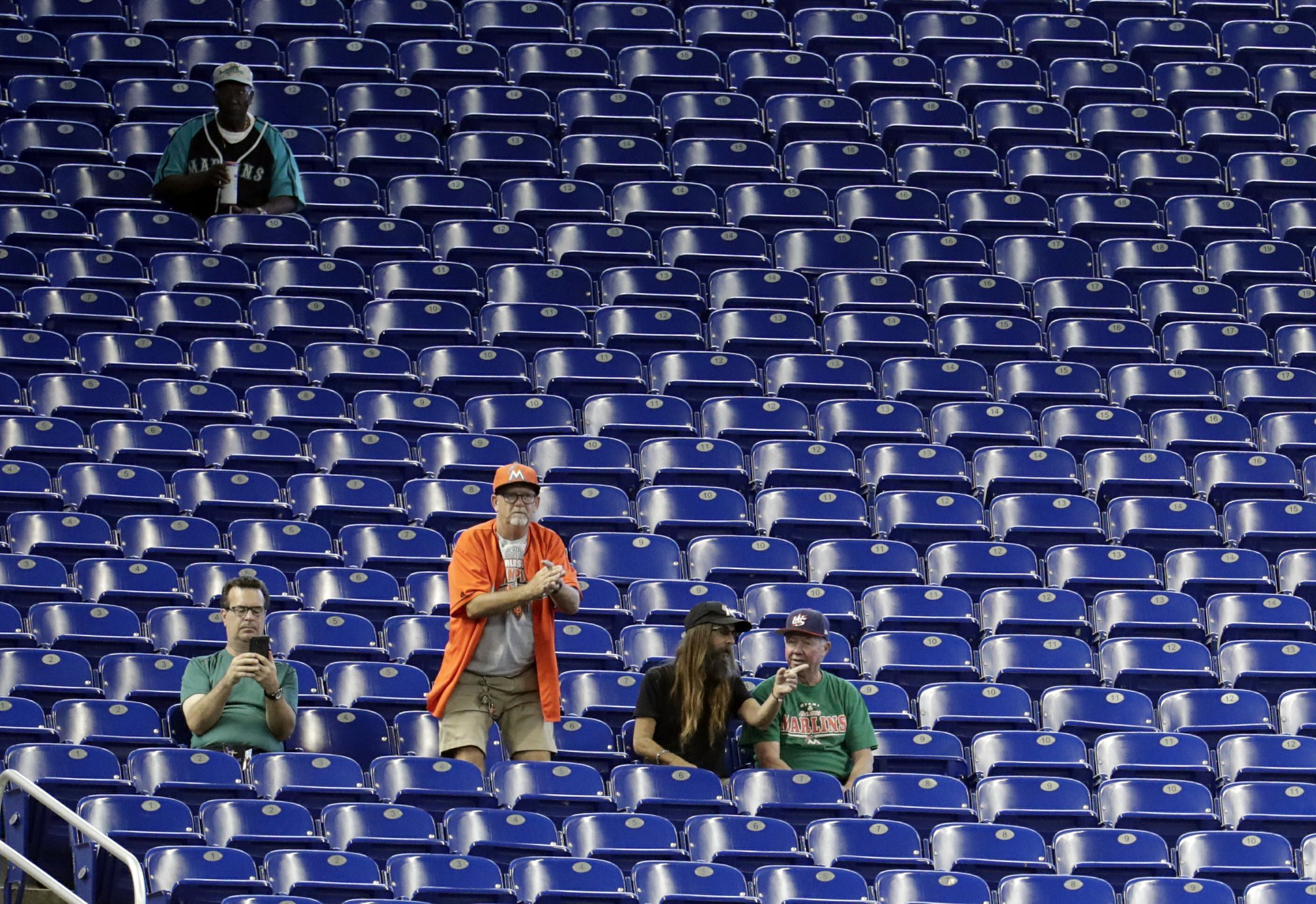Baseball finds itself with a real numbers problem

Fans watch a baseball game between the Miami Marlins and San Francisco Giants, Thursday, May 30, 2019, in Miami. Major League Baseball’s average attendance of 26,854 is 1.4% below the 27,242 through the similar point last season, which wound below 30,000 for the first time since 2003. Baltimore, Cincinnati, Minnesota and Tampa Bay set stadium lows this year. Kansas City had its smallest home crowd since 2011, and Toronto and San Francisco since 2010. Miami and the Rays drew 12,653 Wednesday night combined. (AP Photo/Lynne Sladky)
The official culprit last season was the weather, which Major League Baseball cited as a big reason for a 4 percent slide in attendance over the previous year.
This season? Well, attendance is down once again — only this time there are new excuses.
Commissioner Rob Manfred blames increased competition for the entertainment dollar, which he says has led to a decline in season ticket sales in some markets. The players’ union, meanwhile, says fans simply won’t come out to watch bad teams that aren’t trying hard enough to get better.
Take your pick, but here’s a third possibility: Baseball is becoming hard to watch, and fans are registering their displeasure by staying home in increasing numbers.
But first, let’s recap MLB’s increasingly troublesome turnstile figures.
Attendance at major league ballparks peaked at an average of 32,785 a game in 2007, not coincidentally at the tail end of baseball’s steroid era. It stood at 26,854 through midweek this season, a drop of nearly 6,000 fans a game in 12 years.
More worrying, perhaps, is that average attendance is down some 3,500 a game since the 2015 season, not coincidentally a time when advanced analytics began changing the way the game is played.
Yes, that includes the paltry turnouts in Miami and Tampa Bay, where on typical nights there are less — in some cases much less — than 10,000 fans in the ballpark. Baseball has become a tough sell in Florida, as anyone who tunes into a game can readily see.
But it goes further than that, even in markets that traditionally have supported their teams over the years.
The Giants sold out every game in San Francisco for nearly seven years running, before the streak of 530 straight was broken in July 2017. It’s true the Giants are a shell of the team they were in winning three world championships, but they’re down to 32,401 fans this year in a ballpark that holds more than 41,000.
In Minnesota the early turnouts were so alarming for the best team in baseball that the team began selling $5 tickets just to get people in seats. Still, the Twins are averaging just over 22,000 a game at Target Field, down more than 5,000 from 2015.
And on a beautiful night in Pittsburgh this week, only 13,059 were motivated enough to come to one of the best ballparks in baseball and watch the Pirates play the Milwaukee Brewers.
It could be that baseball is just finding its new level after new ballparks and more (steroid aided) home runs helped fuel the attendance boom that peaked in 2007, just before the great recession. Indeed, it might be unrealistic to expect that baseball would average 2.5 million fans a season again across each of its 30 teams.
Still, 6,585 for an early season game against Oakland in a Baltimore ballpark that once automatically sold out every game? Or, more recently, 8,076 on Thursday night in Tampa Bay for the first place Twins?
One theory is that baseball is losing its true fans, the ones who appreciate the game and how it unfolds over nine innings. They’re increasingly frustrated watching a game that features little strategy, lots of time consuming pitching changes, and more strikeouts than hits.
They wonder what happened to the stolen base, the sacrifice and the hit-and-run. They’re baffled when they see teams playing the shift with the bases loaded in the ninth inning of a tie game with a hitter who doesn’t even try to beat it to win a game.
They’re tired of watching everyone swing for the fences with two strikes, and weary of the game being stopped so umpires can gather with headsets to see whether someone’s fingers came off a bag for a nanosecond.
Yes, the casual fans still come for family outings and the experience of a night at the ballpark. Teams like the Cardinals and Dodgers still draw big crowds, and the Phillies with Bryce Harper are packing them in.
But the trend is unmistakably downward, much like World Series television ratings that are near all-time lows.
Baseball has a numbers problem in more ways than one.